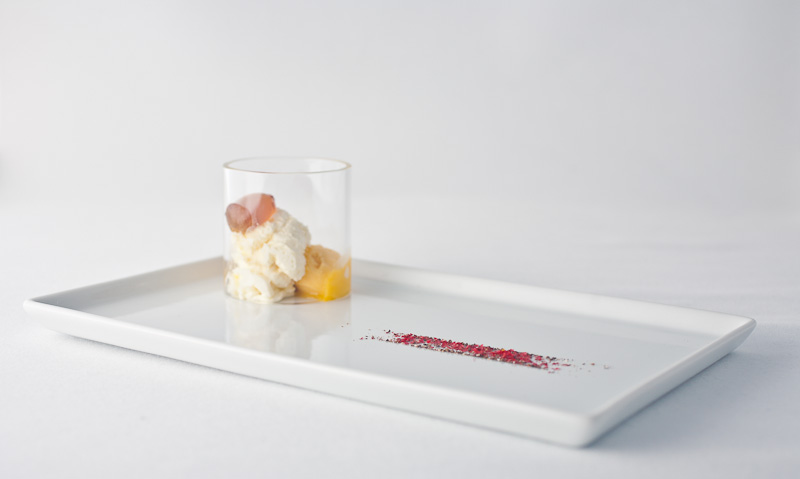
You guys, I’m a little bit excited about this recipe: it’s not in the book. I made it up.
So, last week at Berkeley Bowl, while shopping for ingredients for the oyster dish, I came across some very odd punnets of berries in the produce section:
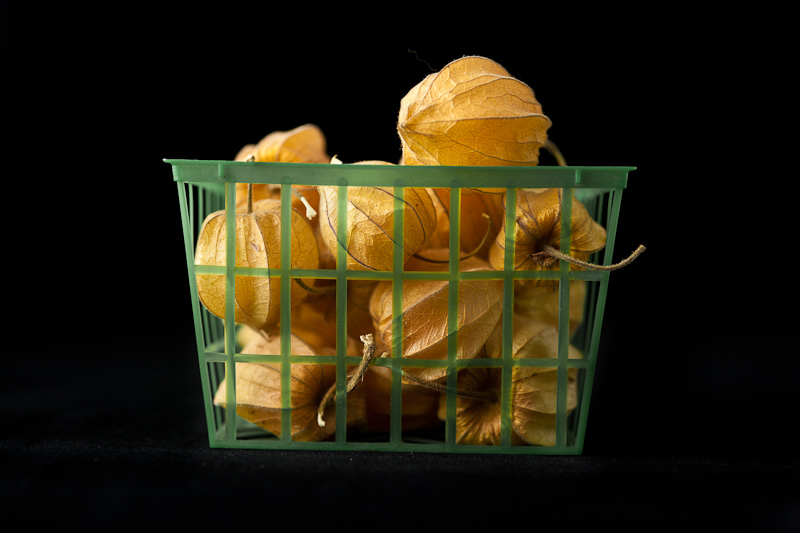
The signs were mixed up on the display, so I had no idea what they were. They were so interesting and pretty, though, that I had to buy them. A woman checking out at the cashier’s line in front of me eyed them curiously and asked me “What are those?”
“I have no idea!” I said excitedly.
She asked what one was supposed to do with them. “I dunno!” I said. “Something! I’m gonna take them home and try to figure them out!”
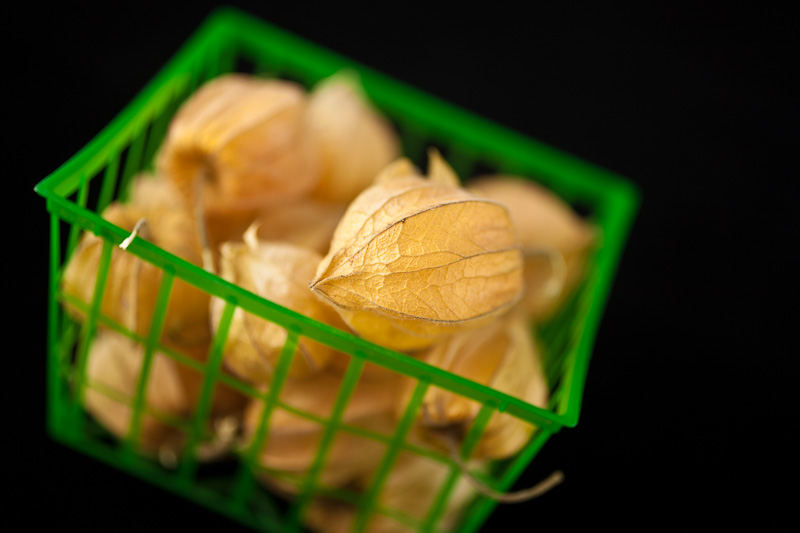
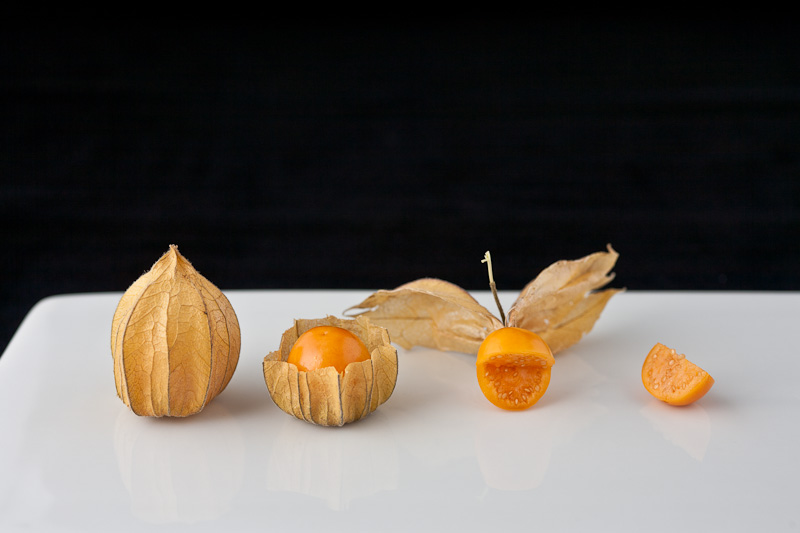
When I got home, a bit of intertubez searching helped me figure out what they were; the berries were cape gooseberries, and were still inside their papery calyx husks (in which, amazingly, they’re able to stay fresh at room temperature for up to 45 days apparently!). I carefully cut one open; on the inside it looks a lot like a tomatillo. It has small yellow seeds inside, and the outer skin is somewhat strong, like that of a tomato. The berries are tart; Sarah immediately said they tasted a lot like crab apples, or maybe like a blend of pineapple and strawberry. The flavor is potent; not quite as acidic as something like a candy Lemonhead or something like that, but not as gentle as a strawberry. A mouthful of these would make you pucker a little.

Since I’ve been on a little sorbet kick lately, I figured I would try to make a sorbet from this–maybe I’d build a pre-dessert palette cleanser. I didn’t really know the best way to go about cooking down the berries; I figured if I boiled them in water, the flavor would get leeched out and diluted. I didn’t want that, so I opted to cook them sous vide at 75c for about 2 hours. I combined them with some sugar before vacuum-sealing them:
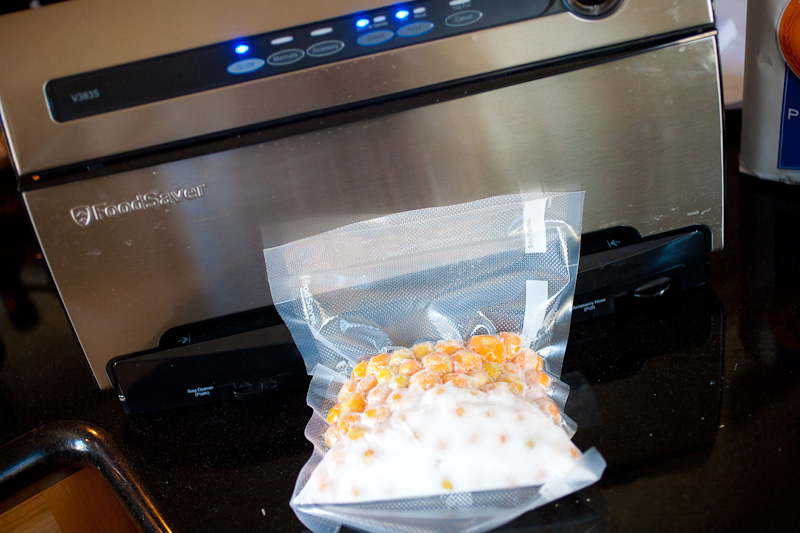
I expected the cooked berries to be quite mushy and pulpy when I took them out of the water bath. I put them in my tamis and tried to push them through:
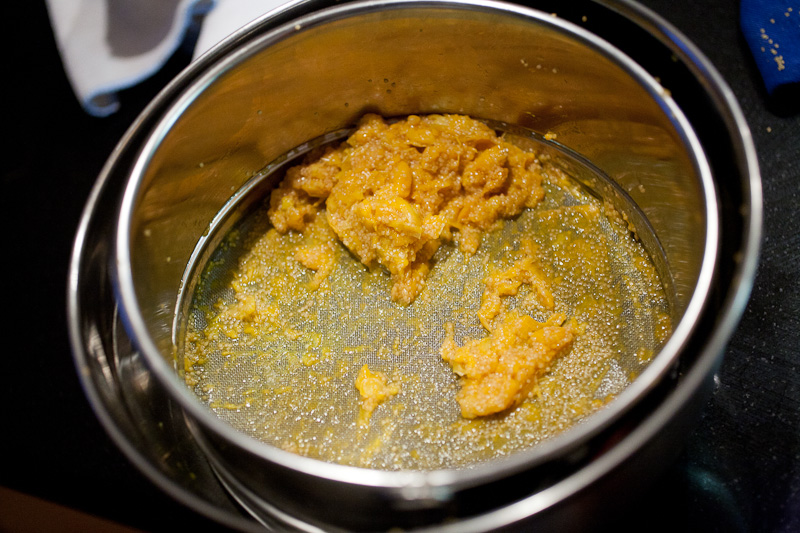
What came through, though, was mostly just juice. It was very tasty and potent, but didn’t have a lot of body.
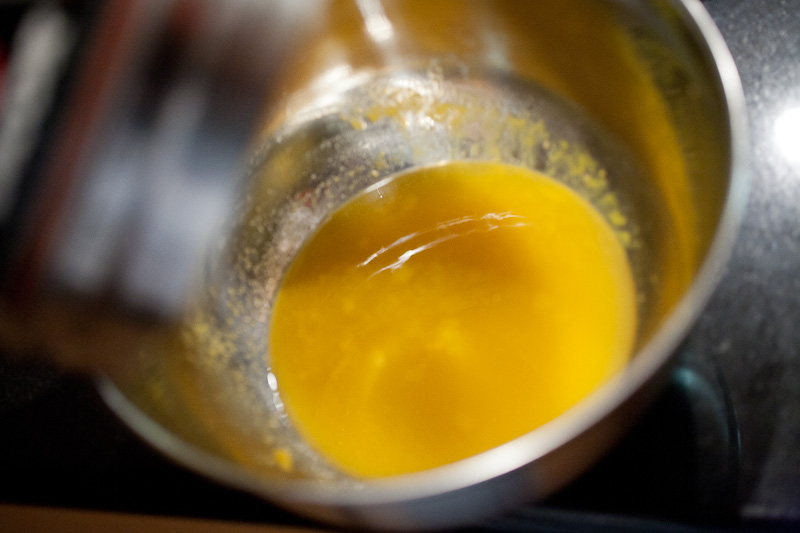
I forged ahead, though, and chucked the juice into my ice cream maker. Half an hour later, I had a nice soft sorbet…that melted almost immediately when I scooped it out with a metal spoon. Even after freezing it overnight, the sorbet was very unstable (either it was very hard and overfrozen, or liquid). Since I’m learning a bit about stabilizers, I decided to try some in this. I reheated the sorbet and mixed in a bit of Stabi-Sorbet; about 1g for 250g sorbet. I erred on the lighter side, not wanting to turn my sorbet into a block of gel. The stabilizer did kick in a bit and firmed up the sorbet when it cooled, but when I refroze it it was still rather unstable and melty. I didn’t want to reheat it a third time to add more stabilizer for fear it’d start to taste bad.
In trying to visualize flavors to pair with these things, I asked myself what paired with strawberries and also with pineapple. The Flavor Bible mentioned rosemary pairs with both, which immediately sounded great. I decided to make a simple rosemary whipped cream. I heated some cream and sugar in a pot, with 4 sprigs of rosemary. Brought to a simmer, then removed from heat and let steep for a half hour. I strained the cream, chilled it, then pressurized it in a cream whipper.
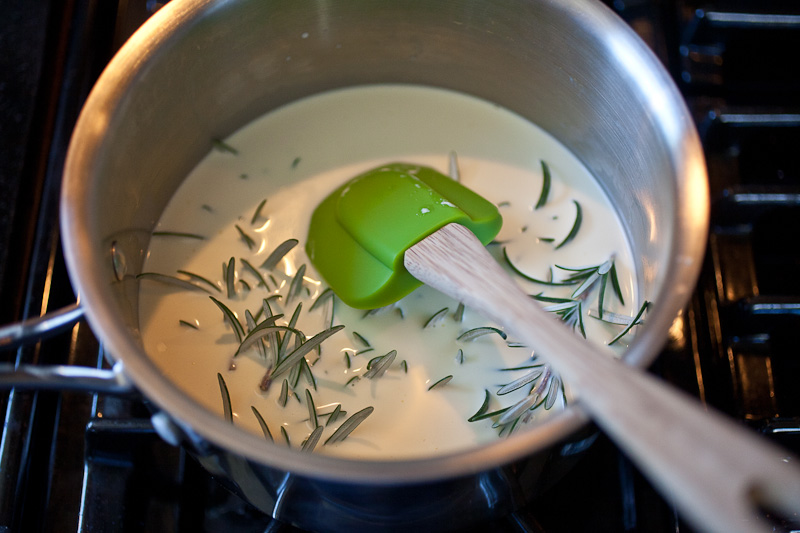
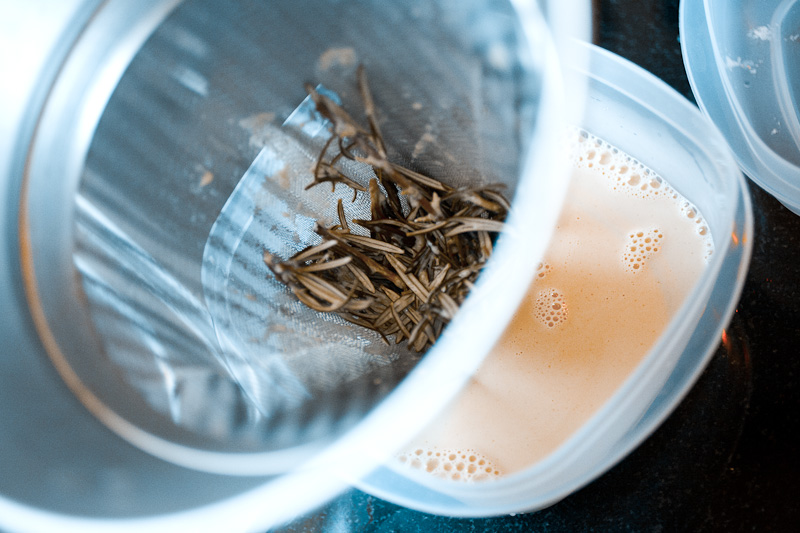
(side note: while I was doing this, I was drinking this beer, an IPA by Mikeller. If you like floral hop notes, this beer is completely awesome.)

Pineapple and strawberries both also pair well with brown sugar/molasses, so I turned back to the idea of the rum sphere from the Guava dish, with a few modifications: both fruits also pair with orange, and I had some Cointreau, so I decided to just make a little cocktail sphere of rum and Cointreau. I mixed together water, brown sugar, rum, calcium lactate, and orange peel, brought to boil, and let steep for 30 minutes again.
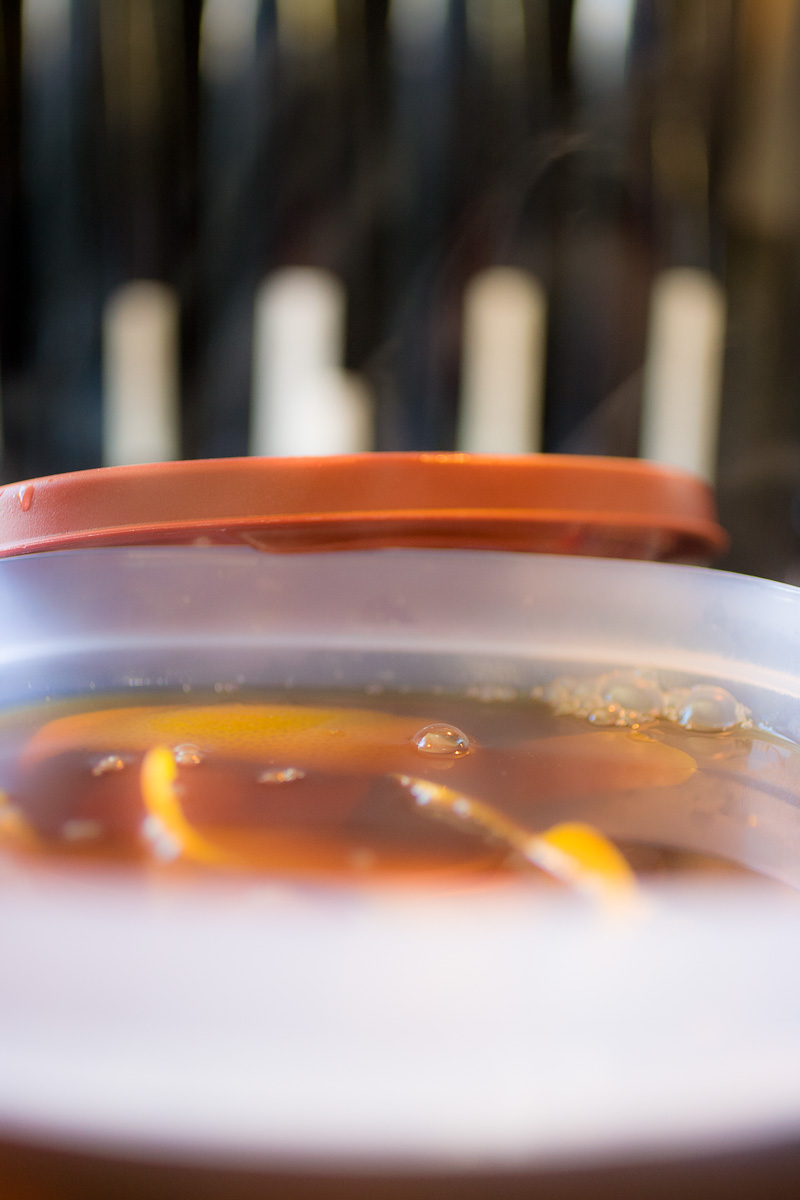
From the resulting mixture, I filled some hemispheric molds then froze them.
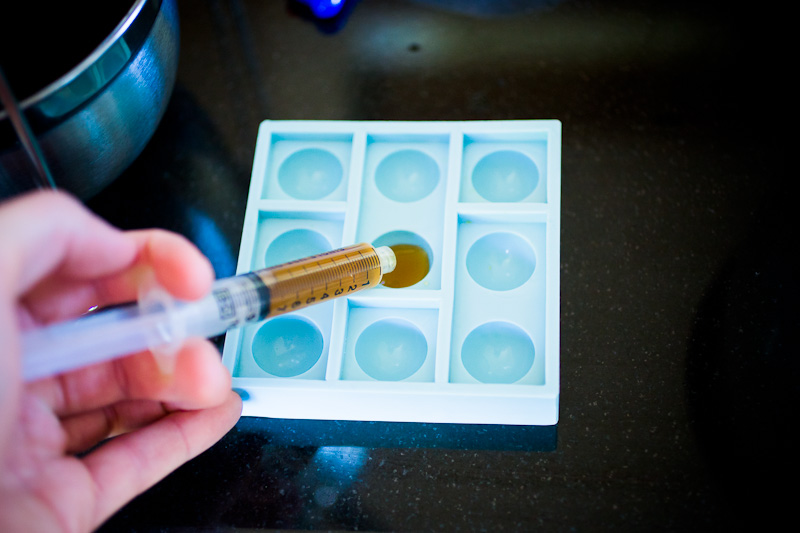
The rum/orange ice cubes I then dropped in a mixture of hot water and sodium alginate to spherify them.
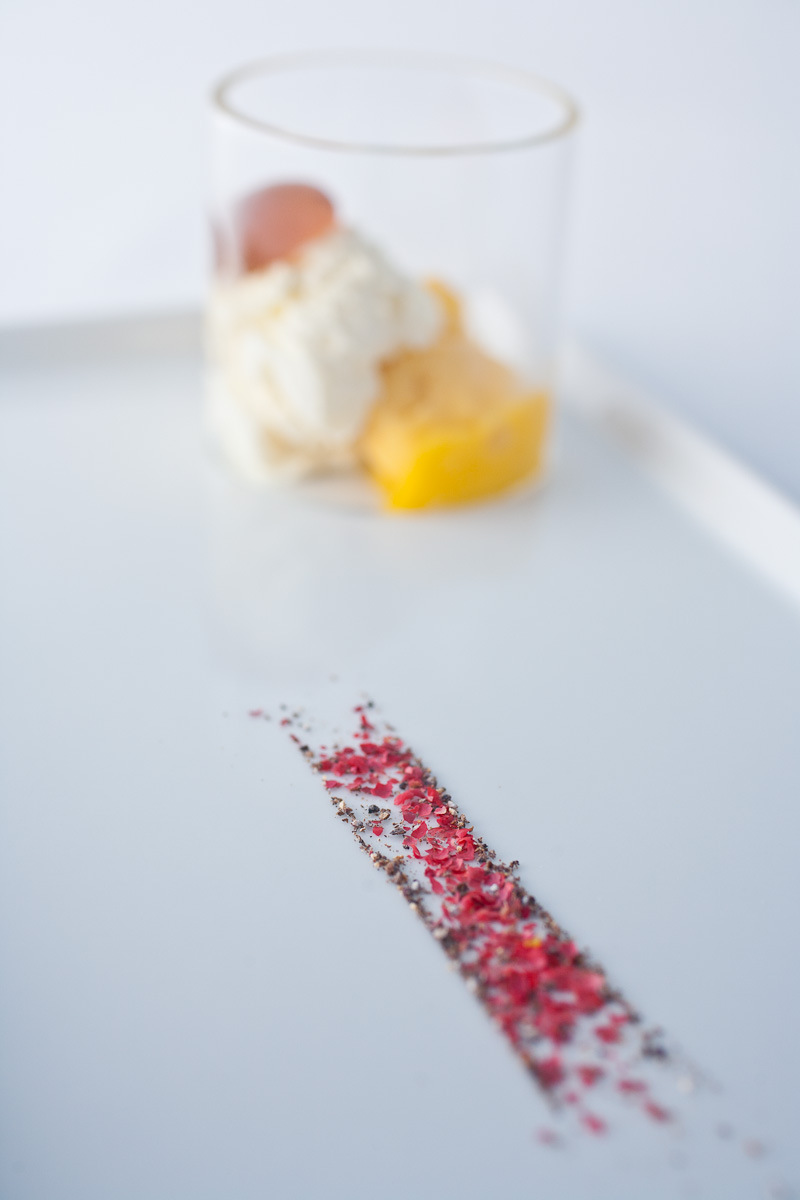
Finally, I wanted to incorporate a peppery note. After tasting a handful of various pepper types, I decided on a mixture of long peppercorns and pink peppercorns. The long pepper has a sort of smoky note, and the pink peppercorns are sweet; both peppers are quite distinctive. I wanted a cool way of presenting them, so I decided to try playing with making a ‘candy wrapper’ out of molten-then-hardened sugar, with encased pepper inside. I’ve never done this before, so I thought it’d be fun to try. I used isomalt because it doesn’t caramelize and remelts easily. After melting a half cupful or so, I poured a tiny bit into a small circular cookie cutter tube.

After waiting a few moments for the sugar to cool a bit, I dropped in a spoonful of peppers then did a little lift-and-twist move to form a hollow chocolate kiss-like shape.
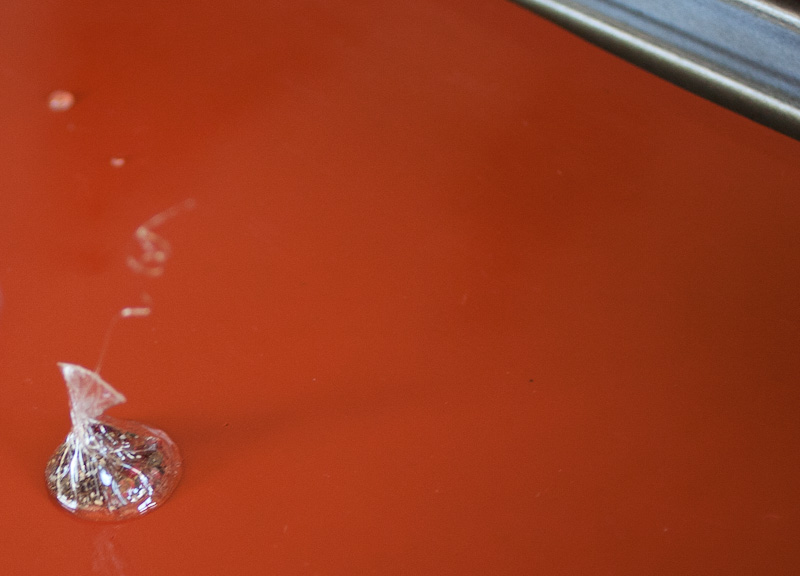

The molten sugar caused the metal tube to heat up enough that I couldn’t hold it for very long. I was moving fast so I grabbed the first thing I could find that would let me hold onto things longer, which happened to be some white duct tape. Working with the sugar was pretty temperamental, and after an hour of playing I only had a few shapes that were reasonably interesting. Still, kinda neat and fun.
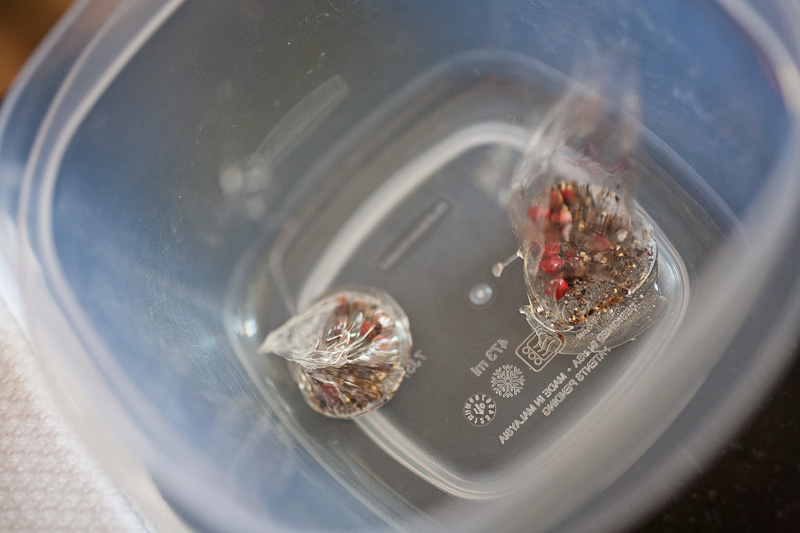
After making all this, I took a crack at plating it. It’s nowhere near where I’d like it to be; the sorbet is shapeless and clearly melts easily, the whipped cream has a ‘rip-y’ quality that makes it not conducive for forming smooth plops of it, and my spheres are a little jagged because I froze them sloppily. So my photos of it are under my bar.
But.
It tastes fully great. Like, I seriously feel proud; it tastes interesting and atomic; I can pick apart all the flavors and they all work really nicely together. The dish is sweet but not cloyingly so, and has a refreshing quality that I like (it’s not ‘heavy’ like a chocolate dessert would be). The spheres play nicely with the rosemary and the sorbet, and I really love the bite of the two peppers when mixed in with everything. The candy wrapper offers a nice textural contrasty crunch. Best of all, I still have two gooseberries left, which I think I’m going to plant so I can hopefully play with these fun things again in the future.
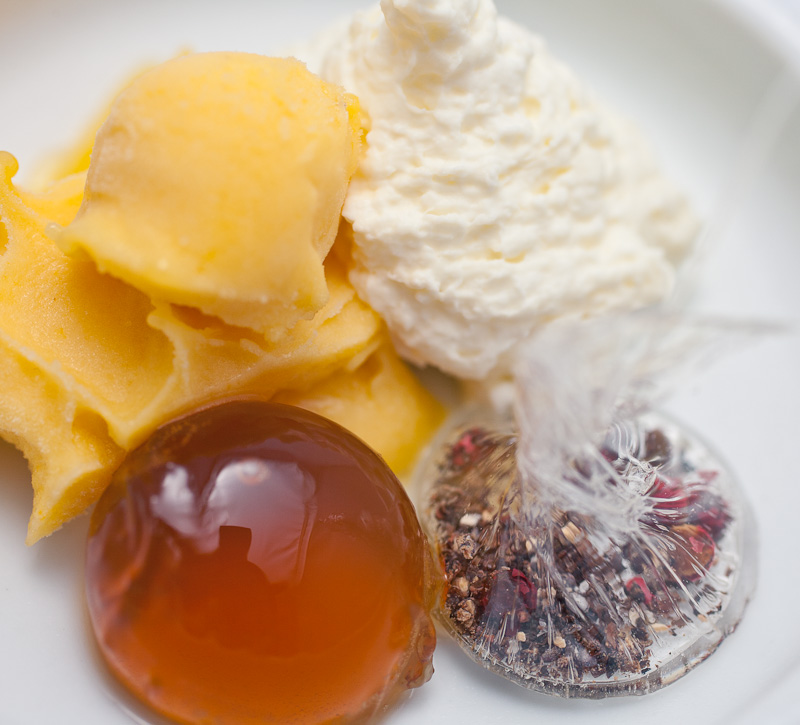
Hello, hope you are doing well. HELP! I am working on the pineapple sheet and when I spread it over the once sprayed and wiped off acetate sheet (with cooking spray) the pineapple mixture seems to not stick to the acetate, I roll it around for it to spread and it scatters, like it won’t stay on. Could it be the oil? I left two acetate sheets with the stuff (food grade acetate I used), one with oil wiped off and the other one with nothing. Any ideas?
Thank you
Hi Norma;
Yup, I had the same experience as well. The oil keeps the pineapple from getting any footing on the acetate, so it’s left to its own surface tension, which makes it kinda draw up into itself a bit. I did a few different things, all of which worked fine really (so, the short version of this answer is: don’t worry! It’ll very likely dry fine): I used a large piece of acetate and a silicone spatula to sort of ‘smear’ the pineapple liquid around to get more coverage and try to fill in holes that formed, and I made sure to wipe the acetate off fairly well after spraying it with oil so that only the thinnest layer remained. I also let the pineapple/ultra-tex mixture cool to room temperature before pouring; this made it thicken a bit and made it easier to smear around on the acetate. And finally, I set a small fan at the other side of the room blowing air gently across the mixture, so that the air circulation would help the drying process.
Make sure you check the Alinea Errata on this one; the recipe as printed in the book is wrong and if followed exactly will just leave you with a big gloopy mess. But if you’re using the corrected recipe, the main thing you’ll need is just some patience and trust that it’ll dry out overnight (maybe longer if it’s been poured more thickly…which is fine).
Thanks Allen. I did one acetate sheet with oil coating and one without. They both worked great although the oil free one worked even better. One question, you mention that you get eight, 3″ squares off of this, I had plenty of pineapple mixture for way more than that… am I wrong?
Thanks again! After doing some recipes off of the Alinea cookbook and the Fat Duck, I will try out some of the ones in the Modernist Cuisine. Have you seen the book? It’s pretty amazing.
Hey Norma;
The Alinea book purports that each recipe has been scaled to yield 8 servings of each dish; I’ve found that in almost every case, I end up with WAY WAY WAY more than that. As I was mentioning earlier when you were asking about scaling down recipes, I think they do this in large part because of the mechanics of things. For example, when I tried quartering the pineapple glass recipe, I found that I had a much smaller amount of juice in my blender when it came time to blend in the Ultra-Tex. When I switched the blender on, all the juice just sprayed up against the sides of the blender carafe; there simply wasn’t enough liquid to keep things moving back down towards the blade of the blender to allow things to blend properly. So, while you DO end up with a ton of stuff, it’s often I find that scaling things down causes trouble with one of the steps involved in making the recipe. So! You’re not doing anything wrong, it’s just sort of a part of doing this stuff I guess. 🙂
I’ve definitely seen of Modernist Cuisine, but haven’t actually gotten a copy to look through yet. Saving up for that one. 🙂
Very nicely done, looks just like an Alinea dish. would be funny if they stole it 🙂
Thank you for answering questions. Like I mentioned a while ago, I live in Nicaragua and lots of ingredients are hard to find here. Since I travel to the states often, I get ingredients then. I am traveling there this week and planning on getting a refractometer, there are so many types and prices, which one should I get. Also, i have gram scale but not one as acurate as to the .01g , any recommendations? By the way, I’ve been experimenting with centrifuge for separating solids and liquids, it is quite amazing. Should thought I’d share that with someone who’d actually be interested.
Hi Norma;
Actually I haven’t yet bought a refractometer; I haven’t come across anything that’s failed outright because of my lack of this device, and I’m trying to rely on taste to help guide my use of sugar. I suspect (though am not 100% certain) that the use of a refractometer is, in many instances, to ensure consistency of sweetness across an entire service season, where variations in fruit ripeness and other things like that might cause flavors to drift from one batch to the next. But at any rate, I couldn’t really offer any opinions on that I’m afraid, sorry!
I AM interested in the centrifuge! Where/how did you get ahold of one? And what have you made with it so far?
Hi Allen, sorry I had not replied sooner. I’m on my way to my office, I’ll write then.
Hi again! Ok, so the centrifuge. I found a used one in a lab here in Nicaragua. You can get a used one from ebay, they have sooo many options. You would want a benchtop centrifuge and make sure it holds larger “buckets” other than just test tubes. It is amazing what you can do with it. I have made tomato water, carrot butter, hazelnut oil, pea juice and other things just fooling around with it. Its basic use is for clarifying liquids and separating fats. You can do something similar by filtering though. It is much cheaper than getting a centrifuge but it takes way longer. It is ice filtration. Where you get a juice for example, weigh it, add 1% of 160 bloom gelatin of total weight of your juice. Pour it on a sheet pan or in a hotel pan (no more that 5cm thick layer). Freeze it. Place a piece of Muslin on a perforated hotel pan, place the frozen block on it (make sure you have a non perforated one on the bottom to catch the liquid when it melts), refrigerate the whole thing for 24-48 hours and you have clarified juice. If you do this with a chicken stock or beef stock, you would not need the gelatin since it already has natural gelatin in it from the bones (you probably already knew that). Anyhow, I am sure you have heard of the grandfather of modern cuisine , Ferran Adria from El Bulli and then came Heston Blumenthal from the Fat Duck. I recommend getting the Fat Duck book, it’s just like $30.00 and /or Heston’s Fantastical Feasts. He is unbelievable. The creativity is beyond anything I have ever seen. Google, or youtube : Heston’s Feasts. Well, hope that helped. I am traveling to the states tomorrow for work and getting some ingredients while at it. Where did you get Fruit Puree’s?
Quick question, one did you receive reply on centrifuge? Two, how big a pieces did you use for the candied dandelion? The largest I found were like 1/2 cm or less. And purees? Were do you find those?
Hi Norma;
I did see that centrifuge info, thanks for that! It’s on my list of toys I want to buy someday. 🙂
Dandelion root: yes, what I found (from a local herbist store) were very small pieces, and I had to sift through to find the biggest ones for plating. Even then, the biggest chunks were around a cm or so. But this turns out to be a good thing; the bigger chunks weren’t terribly pleasant to eat. They were chewy and the candying process didn’t permeate to the centers of those pieces…it was the smaller pieces that tasted really nice.
Fruit purees: I talk a bit about my experience with this in the Guava dish:
http://www.allenhemberger.com/alinea/2011/05/guava-avocado-brie-key-lime-juice/
Ultimately I bought from these guys, based largely on their pricing:
http://www.markys.com/caviar/customer/french-frozen-fruits-and-fruit_purees/
The puree I got was totally fine. But before purchasing from them, I just did a lot of googling for “fruit puree” or (in the case of that dish) “guava puree”.